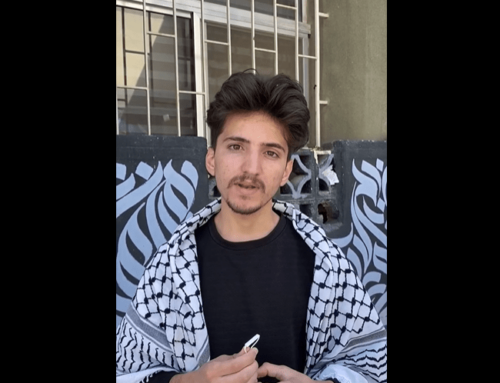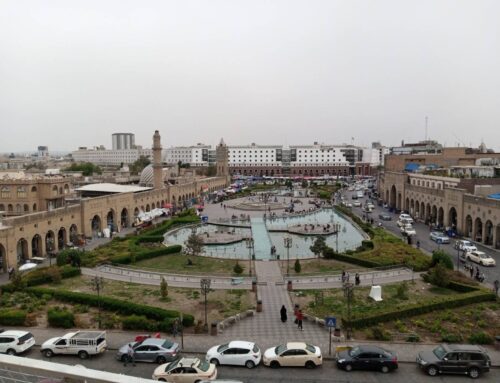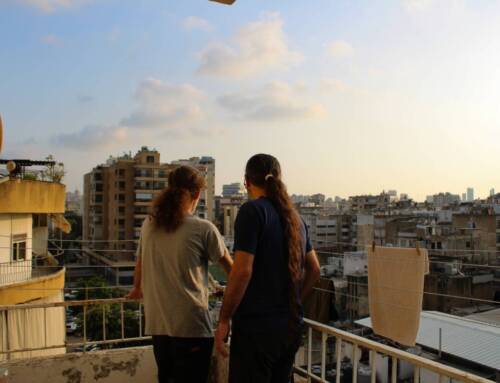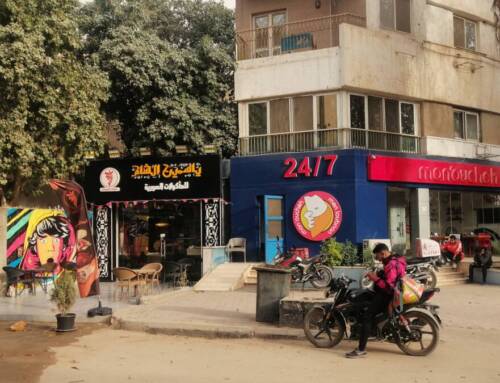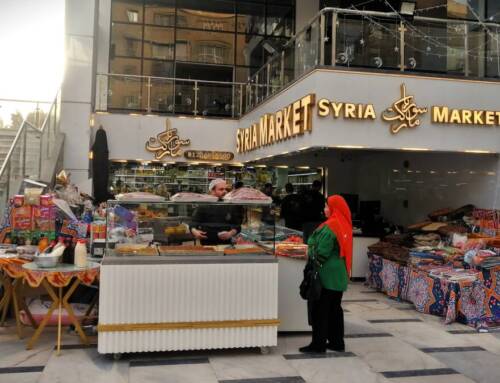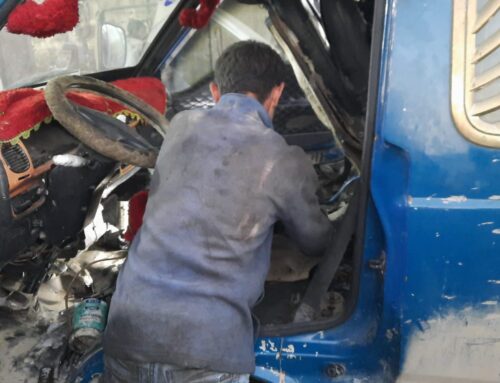‘Those who must go, must go’: As the years drag on in Rukban camp, pregnant women face strapped medical services or a risky return home
Rukban women enter UN-run clinic in Jordan in March 2017. Photo by […]
4 October 2018
Rukban women enter UN-run clinic in Jordan in March 2017. Photo by Khalil Mazraawi/AFP.
AMMAN: Bishayr is terrified of giving birth. Originally from rural Homs, the 19-year-old fled her hometown after the Islamic State stormed the surrounding countryside, and later settled down and married in the remote Rukban displacement camp in Syria’s southeastern desert.
She is now in her third trimester, her due date rapidly approaching.
And though four different midwives in the camp have told her she’s progressing “well,” she remains nervous for the coming weeks.
“This is my first child,” Bishayr tells Syria Direct via WhatsApp from inside the makeshift settlement, requesting that her real name be withheld in this report for fear of government reprisals should she return to her hometown in the future. “A woman’s first birth is difficult, and I’m scared that something bad might happen.”
In isolated Rukban, which was an uninhabited swathe of desert before it became the site of a displacement camp several years ago, that is not a distant possibility. “There are no doctors here,” Bishayr says, fearing what that could mean if her pregnancy—or birth—take an unexpected turn for the worse.
What was once a makeshift tent settlement for people mostly displaced from formerly Islamic State-held territories in eastern Syria has gradually transformed into a sprawling desert town with livestock markets, mud schoolhouses and cinder-block grocery stores. After several years stranded in the desert along the eastern Syrian-Jordanian border, an estimated 50,000 displaced Syrians in the underserved Rukban camp have done their best to move on with normal life: home-building, courtship, marriage.
But for Rukban’s thousands of women and girls, life in this barren desert landscape presents yet another, potentially fatal, milestone: pregnancy and childbirth.
And following the roughly week-long cutoff in access late last month to a UN-run medical point just across the border in Jordan, local nurses as well as pregnant women and girls within Rukban say they are more worried than ever.
The UN medical point remains a vital cross-border lifeline for the tens of thousands of displaced Syrians still living in Rukban, where only a skeletal network of poorly served nurses’ clinics operate. The clinics are desperately low on supplies, according to medical staff and humanitarian workers inside the camp, while medicine is prohibitively expensive—when it’s actually available.
And though access to the medical point resumed on September 22, when 232 Rukban residents were reportedly admitted into Jordan for treatment, nurses inside Rukban told Syria Direct of at least seven pregnant women who were in dire need of C-sections—procedures unavailable in the camp’s own rudimentary clinics—during the closure.
For Bishayr, whose pregnancy still reportedly appears healthy as she approaches the final weeks, the uncertainty over whether she’ll be admitted to the UN facility is only fueling her fears.
“Yes, my [pregnancy] is going normally,” she says. “But I’m very scared.”
“Pregnancy in this camp is very difficult, and that fear accompanies women…until the birth is over.”
Scarce medical care
Giving birth in Syria didn’t always equate to psychological trauma.
In 2010, one year before the outbreak of protests that would later herald Syria’s descent into war, the country’s maternal mortality rate stood at a relatively safe 49 deaths per 100,000 live births—a rate close to those of Iraq and Malaysia, according to UN data.
But by 2015, following several years of fighting and displacements throughout the country, that rate had risen to 68 maternal deaths per 100,000 live births. It remains unclear whether that count, the latest available, includes formerly opposition-held areas—like East Ghouta, where a five-year government siege devastated local healthcare services and medical infrastructure.
Roughly half a million pregnant girls and women in Syria are in need of “immediate assistance” as a result of the war, the UN’s Population Fund (UNFPA) estimated in April, though 1.5 million Syrian women and girls are thought to live in areas—like Rukban—where there is “limited aid available.”
A Rukban store selling herbs and traditional medicines. Photo courtesy of Abu Mohammad al-Akidi.
In Rukban, no medical services existed before the war. The settlement’s tents and mud homes huddle within a vast expanse of open desert populated by only a handful of local smugglers and bedouin tribes. A single thoroughfare—the Baghdad-Damascus highway—threads through the empty landscape near a US-run coalition outpost on the Syrian-Iraqi border.
Dust storms are common, sweeping the dusty desert town regardless of season. Frigid winter rains turn the ground to mud as viral diseases spread with little medicine on hand to treat them. Meanwhile, summer brings little respite from camp-wide outbreaks of hepatitis A and diarrhea, with children often the most vulnerable. Dozens of impromptu gravesites dot the open spaces between houses and shops.
And yet it was in Rukban that families fleeing the Islamic State in eastern Syria first began seeking refuge in mid-2014, in a strip of no-man’s-land between the Syrian and Jordanian borders known as the “berm,” in the hope that someday they’d enter Jordan via a crossing that was still sporadically open at the time.
However, that crossing was closed fast by the Jordanian government in 2016, and the surrounding area declared a “military area,” after an IS-claimed car bombing killed seven Jordanian soldiers stationed at an outpost near Rukban.
Even so, people stayed. UN satellite imagery since 2016 tells a story of ongoing displacements, with the camp expanding as Syrians continued to flee battles across the country’s eastern desert.
Now, doctors and aid workers are barred from entering the berm to provide assistance. What little medicine remains available inside the camp typically arrives via smugglers coming into the camp from Syrian government-held territory, before being sold at a nearly 50 percent markup, Rukban resident Hadhar al-Hussein, who helps run a small aid distribution center, told Syria Direct last month.
The last aid delivery occurred in January, via cranes that dropped the parcels over an earthen barrier demarcating the border line.
A ‘catastrophe for women’
Rukban nurse Ruba al-Homsi is one of an unknown number of medical professionals who treat residents inside the camp, after being displaced to the makeshift border settlement themselves.
“Every day we’re losing a patient’s life due to a lack of aid,” al-Homsi says.
While her clinic provides rudimentary care when medicine and other supplies are available, she also works to transfer patients in her care to the UN-run clinic across the border when their needs are beyond her clinic’s abilities.
Patients in need of more advanced care—including operations—can then transfer from the UN’s clinic to better equipped hospitals deeper inside Jordan.
The UN’s most recent data on its Rukban clinic documented 44 referrals to Jordanian hospitals—out of a total 73 referrals—for “reproductive health services” during August. More than 1,400 Rukban residents received reproductive health services inside the clinic itself during that same period.
But a local rebel faction present on the Syrian side of the border reportedly halted access to the clinic last month for yet unclear reasons, meaning thousands of Rukban patients were unable to cross for over one week.
At al-Homsi’s field clinic in Rukban, some seven women in need of C-sections were reportedly unable to enter the UN facility during the cutoff. All seven were “several days” overdue for giving birth, al-Homsi says—posing significant danger to them had the cutoff gone on longer.
Among the patients temporarily cut off from the UN-run center, al-Homsi says, was her own aunt, who was pregnant with her eighth child and in need of a C-section. “We waited an excruciating week until we were finally able to get her into the [UN] clinic,” she tells Syria Direct.
Reema a-Shami, a midwife in Rukban, called the cutoff a “catastrophe for women.”
“Delays in childbirth could lead to death for the mother or the infant,” a-Shami told Syria Direct.
Between September 11-21, “patients from Rukban were not able to access the clinic,” David Swanson, a spokesman for the UN’s Regional Office for the Syria Crisis told Syria Direct on Thursday.
However, he added, the clinic itself was “never closed.”
Some residents last week blamed a local rebel group for cutting off access from the Syrian side, amid separate reports of potential upcoming evacuation operations.
Officials from UNICEF and UNFPA, the two UN agencies in charge of the facility, did not immediately provide further comment on operations there after access was restored in late September.
Maternal deaths push mothers back to government territory
Hard statistics on Rukban’s birth rate are difficult to come by due of a lack of any established camp-wide medical system.
Shukri Shehab, head of a clinic inside the camp, estimated around 400 births at his facility alone during the first six months of 2018.
“As for the camp as a whole, it’s very difficult [to estimate],” he added, noting there were at least two other clinics in the camp where women who didn’t need C-sections could go to give birth.
Shehab told Syria Direct his clinic had seen no maternal deaths in 2018, though he said he knew of one pregnant camp resident dying earlier this year of preeclampsia in a separate Rukban-based clinic. Preeclampsia is a typically late-term pregnancy complication featuring high blood pressure.
Syria Direct could not independently confirm the reported death. A midwife at Ruba al-Homsi’s clinic said none of her pregnant patients had died in 2018.
The risks to their lives are pushing some mothers to consider a potentially dangerous trip back into Syrian government-held territory to give birth in hospitals there instead.
Returning can simply mean the lesser of two evils: risk going into labor in a desolate, unhygienic border camp if they can’t make it to the UN facility in time, or face possible arrest while smuggling themselves past Syrian security checkpoints in search of a certified hospital near home.
Maha, a pregnant woman in her third trimester, is torn about the decision. Speaking to Syria Direct during the UN clinic cutoff last month, she said she “definitely” needed a C-section, as her previous children were born that way, but added that she feared return to her hometown in government-controlled Syria.
“I’m scared of getting arrested,” said Maha, also requesting that her real name be withheld for fear of government reprisals. “What will happen to me?”
‘Those who must go, must go’
Bishayr says she too is considering the option of a hospital in Syria, despite the fear of arrest. For her, that fear is palpable—her husband, whom she married after arriving in Rukban, is a former fighter from the Free Tribes Army, a rebel faction with a presence in and around the camp.
Though the 19-year-old was recently able to enter the UN-run medical clinic for a routine checkup, she says sometimes she must wait “10 days or more” for a chance to see doctors in the facility—a period of time that could mean life or death as she nears her due date.
When speaking of her fears with Syria Direct, Bishayr recalls one of her relatives who gave birth earlier this year. As with Bishayr, nurses inside Rukban reassured her relative that her pregnancy was “normal,” that she’d be able to give birth vaginally in the camp without entering Jordan for emergency care.
Her relative soon passed her due date with no sign of labor, as nurses in Rukban told her there was “nothing they could do,” Bishayr says. Fortunately, she was able to make it to the UN facility, then onward into Jordan, for an emergency C-section.
But with the recent cutoff in access to the clinic, Bishayr is scared she may not be as lucky should her own pregnancy face dangerous complications.
“I’m scared there’ll be difficulties with the birth,” she tells Syria Direct. “If I get too scared to give birth [in Rukban] and I can’t get into Jordan, I’ll go to Damascus.”
“People are afraid of arrest, but those who must go, must go.”
This report is part of Syria Direct’s month-long coverage of internal displacement in Syria in partnership with the Konrad Adenauer Foundation and reporters on the ground in Syria. Read our primer here.





